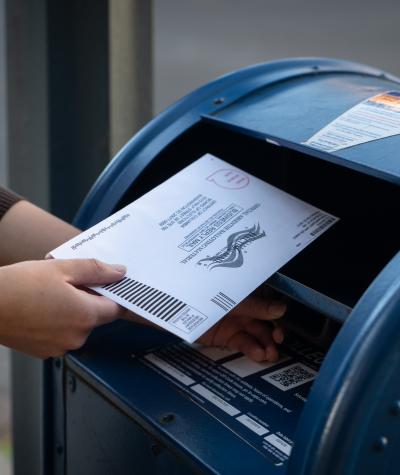Our democracy works best when every voter can participate, and voting by mail is a secure way for voters to make their voices voice heard.
President Trump has voiced his opposition to vote-by-mail, even suggesting he would try to end this method of voting via executive order. But voters should rest assured that the president does not have this authority.
Additionally, any action to curtail vote-by-mail would not make our elections more safe or secure; it would only create barriers for Americans who want to exercise their freedom to vote.
What is vote-by-mail?
Vote-by-mail — sometimes called absentee voting — is a safe, secure and accessible way to vote that has existed since the Civil War and is used in red, blue and purple states alike.
In fact, in eight states — California, Colorado, Hawaii, Nevada, Oregon, Utah, Vermont, and Washington and the District of Columbia — absentee ballots are automatically sent to every registered voter in case they would like the option to vote by mail.
Vote-by-mail has been a popular option over the last few election cycles. In 2016, 21% of voters cast their ballots by mail. This number increased to 43% in 2020, partially in response to the COVID-19 pandemic. Vote-by-mail remained a popular choice for voters in 2024, with 30.3% casting their ballot by mail that year.
These numbers show that vote-by-mail remains a popular and accessible tool for voters across the country. Additionally, vote-by-mail is particularly important for military and overseas voters who want to make their voices heard during an election, as well as rural voters and voters with disabilities who may not be able to vote in person.
How does vote-by-mail work?
To vote by mail, registered voters usually request a ballot from their local elections office through a safe and secure process. The ballot usually comes with two envelopes to help maintain the security and privacy of the ballot. Voters first fill out their ballot and place it in a small, sealed envelope.
The completed and sealed ballot is then placed inside a second envelope, on which the voter must sign to swear — under penalty of perjury — that they are eligible to vote in that election.
If a voter lies about their eligibility, they could face serious consequences, including fines, incarceration, and potentially immigration consequences, including deportation.
From there, the voter can either mail their ballot or drop it off in-person at an early vote center, secure ballot drop box or at their polling place on Election Day.
Just like voting on Election Day, voters who cast their ballot early or by mail have their identity and eligibility verified by teams of local election officials.
Can I trust that my vote will be accurately counted if I vote by mail?
Yes. Mail-in ballots are verified multiple times to maintain the integrity of the vote. In many states, the ballot transportation, handling, and counting processes are overseen by a team of bipartisan election officials. These officials first verify the voter’s name and information and confirm the voter is properly registered.
Then, election officials remove the sealed ballot from the outer envelope containing the voter’s identifying information to ensure the vote remains anonymous and confidential when the ballots are counted.
Overlapping security measures ensure every voter’s ballot is counted once and is counted accurately.
While methods vary, every state has a procedure to maintain the chain of custody and ensure ballots are not tampered with. Ballots are stored in locked containers, handled by multiple people at a time to maintain integrity, and/or are under 24-hour surveillance.
Many states also have ballot tracking procedures that let voters know the status of their ballot from the moment it is cast to when it is counted. Taken together, all these measures help make sure our elections are secure, and results are accurate.
How does mail voting strengthen our democracy?
Access to vote-by-mail, when offered in addition to early voting and in-person voting, makes our democracy stronger by expanding access to the ballot for more voters.
Unfortunately, some states have taken steps to restrict access to vote-by-mail. In 2021, Kansas passed a law that makes it more difficult for organizations to help voters request a vote-by-mail ballot. CLC sued Kansas over the law and won, permanently blocking components of the law from going into effect.
The Trump administration is also voicing its opposition to vote-by-mail, despite the fact that it has proven to be a safe and reliable way for voters to make their voices heard. In fact, President Trump himself has voted by mail in past elections.
Every American should have the freedom to vote by mail as this secure and accessible method can ensure more Americans can make their voices heard. Having a variety of voting options has given people like working parents, older Americans and people with disabilities greater access to the ballot.
With your support, Campaign Legal Center will continue to advocate on behalf of voters, litigate against anti-voter efforts and advance policies that ensure every American can make their voice heard in our elections.
Former Campaign Legal Center legal intern Lica Porcile contributed to this blog.

